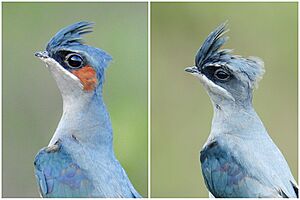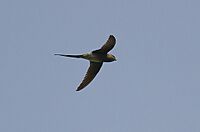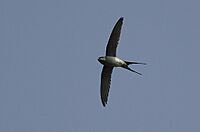Crested treeswift facts for kids
Quick facts for kids Crested treeswift |
|
|---|---|
 |
|
| The male (left) has chestnut ear covers while the female (right) has a white moustachial stripe. | |
| Conservation status | |
| Scientific classification | |
| Genus: |
Hemiprocne
|
| Species: |
coronata
|
| Synonyms | |
|
Dendrochelidon coronatus |
|
The crested treeswift (Hemiprocne coronata) is a special type of bird called a tree swift. For a while, people thought it was the same as the gray-rumped treeswift. But even where they live in the same areas, these two birds do not have babies together. This means they are different species. You can spot the crested treeswift by its long, curved wings and a tail that looks like a deep fork.
Contents
What Does the Crested Treeswift Look Like?
The crested treeswift is a large, thin bird, about 23 centimeters (9 inches) long. Its back is a soft dove gray, and its belly is white. Its long, swept-back wings are a darker gray. This bird has a small crest on its head and a long, deeply forked tail.
Spotting Males and Females
Adult male crested treeswifts have bright orange cheeks and ear covers. They also have a thin white line just under their eyes. Females have a thin white stripe that runs along their cheek, below the eye.
Young Birds and Their Look
Young crested treeswifts have dark gray heads and wings. Their feathers have white edges, making them look a bit streaky. Their other soft feathers are also much streakier than adult birds.
How They Fly and Perch
These birds are often seen flying in small groups. They make wide circles in open forests. Sometimes, they land on top of a tall tree that has no leaves. When they perch, they sit very straight up.
What Does It Sound Like?
The call of the crested treeswift is a harsh sound. It can sound like kee-kyew or a three-note kip-kee-kep. The middle note is usually the loudest.
Where Do Crested Treeswifts Live?
The crested treeswift is a common bird that lives in many parts of Asia. You can find them in countries like India, Sri Lanka, Bhutan, Bangladesh, and Nepal. They also live in Myanmar, Thailand, Vietnam, Cambodia, Laos, and China.
Their Favorite Places to Live
These birds prefer open woodlands and forests where trees lose their leaves. They also like open areas near trees, parks, and even gardens. Most crested treeswifts live in low-lying areas, usually below 1,000 meters (about 3,300 feet) in height.
How Do Crested Treeswifts Behave?
The crested treeswift builds a very small nest. It has thin walls and is shaped like a shallow cup. They make their nests from small pieces of bark and feathers. They use their own saliva to glue the nest to the side of an open tree branch.
Eggs and Incubation
The female bird lays one blue-gray egg. Both the male and female birds take turns sitting on the egg to keep it warm. The nest is so tiny that when a bird is sitting on the egg, it looks like they are just normally perched on a branch. Almost half of the egg can be seen above the edge of the nest. The parent bird covers it with the soft down feathers from its chest and belly.
Breeding Season
The breeding season for these birds is during the hottest part of summer, from March to July. They often place their nests on the eastern side of a branch. This way, the adult bird will have the sun on its back in the afternoon, keeping it cooler. Females spend more time sitting on the egg, while males often sit nearby or catch insects.
Baby Birds and Safety
Young crested treeswifts have patterns that help them blend in with their surroundings. When they feel threatened, they freeze. They hold their head low and their beak slightly up. This makes them look like a knot on a tree branch. If they sit flat, they can look like a chameleon.
What Do They Eat?
Crested treeswifts catch their food while flying. They eat insects, including honey bees, catching them with their beaks in the air. Sometimes, many of these birds will gather together to rest in one spot.
Are Crested Treeswifts in Danger?
The crested treeswift lives across a very large area. The number of these birds seems to be steady, and they are quite common. Because of this, the IUCN (International Union for Conservation of Nature) has listed them as a species of "Least Concern". This means they are not currently at risk of disappearing.




